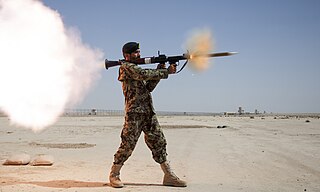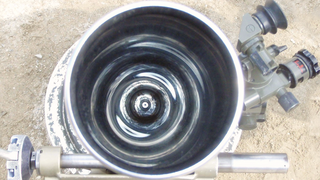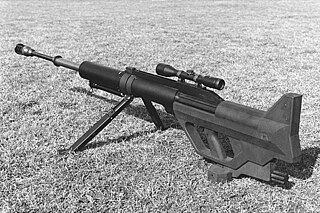
Armour-piercing ammunition (AP) is a type of projectile designed to penetrate armour protection, most often including naval armour, body armour, and vehicle armour.

In guns, particularly firearms, but not artillery, where a different definition may apply, caliber is the specified nominal internal diameter of the gun barrel bore – regardless of how or where the bore is measured and whether the finished bore matches that specification. It is measured in inches or in millimeters. In the United States it is expressed in hundredths of an inch; in the United Kingdom in thousandths; and elsewhere in millimeters. For example, a US "45 caliber" firearm has a barrel diameter of roughly 0.45 inches (11.43mm). Barrel diameters can also be expressed using metric dimensions. For example, a "9 mm pistol" has a barrel diameter of about 9 millimeters. Since metric and US customary units do not convert evenly at this scale, metric conversions of caliber measured in decimal inches are typically approximations of the precise specifications in non-metric units, and vice versa.

A recoilless rifle (rifled), recoilless launcher (smoothbore), or simply recoilless gun, sometimes abbreviated to "RR" or "RCL" is a type of lightweight artillery system or man-portable launcher that is designed to eject some form of countermass such as propellant gas from the rear of the weapon at the moment of firing, creating forward thrust that counteracts most of the weapon's recoil. This allows for the elimination of much of the heavy and bulky recoil-counteracting equipment of a conventional cannon as well as a thinner-walled barrel, and thus the launch of a relatively large projectile from a platform that would not be capable of handling the weight or recoil of a conventional gun of the same size. Technically, only devices that use spin-stabilized projectiles fired from a rifled barrel are recoilless rifles, while smoothbore variants are recoilless guns. This distinction is often lost, and both are often called recoilless rifles.

High-explosive anti-tank (HEAT) is the effect of a shaped charge explosive that uses the Munroe effect to penetrate heavy armor. The warhead functions by having an explosive charge collapse a metal liner inside the warhead into a high-velocity shaped charge jet; this is capable of penetrating armor steel to a depth of seven or more times the diameter of the charge. The shaped charge jet armor penetration effect is purely kinetic in nature; the round has no explosive or incendiary effect on the armor.

A mortar today is usually a simple, lightweight, man-portable, muzzle-loaded cannon, consisting of a smooth-bore metal tube fixed to a base plate with a lightweight bipod mount and a sight. Mortars are typically used as indirect fire weapons for close fire support with a variety of ammunition. Historically mortars were heavy siege artillery. Mortars launch explosive shells in high-arching ballistic trajectories.

An anti-personnel weapon is a weapon primarily used to maim or kill infantry and other personnel not behind armor, as opposed to attacking structures or vehicles, or hunting game. The development of defensive fortification and combat vehicles gave rise to weapons designed specifically to attack them, and thus a need to distinguish between those systems and ones intended to attack people. For instance, an anti-personnel landmine will explode into small and sharp splinters that tear flesh but have little effect on metal surfaces, while anti-tank mines have considerably different design, using much more explosive power to effect damage to armored fighting vehicles, or use explosively formed penetrators to punch through armor plating.

Shoulder-fired missile, shoulder-launched missile or man-portable missile, among other variants, are common slang terms to describe high-caliber shoulder-mounted weapons systems; that is, weapons firing large, heavy projectiles ("missiles"), typically using the backblast principle, which are small enough to be carried by a single person and fired while held on one's shoulder. The word "missile" in this context is used in its original broad sense of a heavy projectile, and encompasses all shells and rockets, guided or unguided. A more formal variant is simply shoulder-fired weapons system and the like.

The Carl Gustaf 8.4 cm recoilless rifle is a Swedish-developed 84 mm (3.3 in) caliber shoulder-fired recoilless rifle, initially developed by the Royal Swedish Army Materiel Administration during the second half of the 1940s as a crew-served man-portable infantry support gun for close-range multi-role anti-armour, anti-personnel, battlefield illumination, smoke screening and marking fire, which has seen great export success around the globe and continues to be a popular multi-purpose support weapon in use by many nations. The Carl Gustaf 84 mm recoilless rifle is a lightweight, low-cost weapon that uses a wide range of ammunition, which makes it extremely flexible and suitable for a wide variety of roles.

A sabot is a supportive device used in firearm/artillery ammunitions to fit/patch around a projectile, such as a bullet/slug or a flechette-like projectile, and keep it aligned in the center of the barrel when fired. It allows a narrower projectile with high sectional density to be fired through a barrel of much larger bore diameter with maximal accelerative transfer of kinetic energy. After leaving the muzzle, the sabot typically separates from the projectile in flight, diverting only a very small portion of the overall kinetic energy.

A smoothbore weapon is one that has a barrel without rifling. Smoothbores range from handheld firearms to powerful tank guns and large artillery mortars.

The Steyr IWS 2000 is an Austrian single-shot bolt-action anti-materiel rifle produced by Steyr Mannlicher. IWS stands for Infantry Weapon System. Unlike other anti-tank rifle designs, it has a smoothbore barrel. This facilitates higher projectile velocities and allows a longer barrel service life, but the lack of gyroscopic spin-stabilization requires the projectile to have aerodynamic stabilizing fins instead. The IWS is chambered in a 15.2×169 mm armor-piercing fin-stabilized discarding-sabot cartridge, and is the first man-portable rifle to use this type of ammunition.

An elephant gun is a large caliber gun, rifled or smoothbore, originally developed for use by big-game hunters for elephant and other large game. Elephant guns were black powder muzzle-loaders at first, then black powder express rifles, then later used smokeless powder cartridges.

A tank gun is the main armament of a tank. Modern tank guns are high-velocity, large-caliber artilleries capable of firing kinetic energy penetrators, high-explosive anti-tank, and cannon-launched guided projectiles. Anti-aircraft guns can also be mounted to tanks.
The Solothurn S18-1000 20 mm was a German anti-tank rifle designed and manufactured in Switzerland and used during the Second World War. It was a variant of the earlier S-18/100 with modifications for a higher muzzle velocity, as well as a larger cartridge size. The more powerful ammunition resulted in significant recoil, which was problematic for the gunner, and its size made portability difficult.

The 14.5×114mm is a heavy machine gun and anti-materiel rifle cartridge used by the Soviet Union, the former Warsaw Pact, modern Russia, and other countries.

The SO-152, usually known by its GRAU designation 2S3, is a Soviet 152.4 mm self-propelled gun developed in 1968, as a response to the American 155 mm M109 howitzer. Development began in 1967, according to the Resolution of the Council of Ministers of the Soviet Union from July 4, 1967. In 1968, the SO-152 was completed and in 1971 entered service. The fighting vehicle also received the added designation Akatsiya (Акация), which is Russian for Acacia.

The 7.5 cm Pak 41 was one of the last German anti-tank guns brought into service and used in World War II and notable for being one of the largest anti-tank guns to rely on the Gerlich principle to deliver a higher muzzle velocity and therefore greater penetration in relation to its size.

An underwater firearm is a firearm designed for use underwater. Underwater firearms or needleguns usually fire flechettes or spear-like bolts instead of standard bullets. These may be fired by pressurised gas.

Ammunition, also known as ammo, is the material fired, scattered, dropped, or detonated from any weapon or weapon system. The term Ammunition includes both expendable weapons, and the component parts of other weapons that create the effect on a target.

A gun is a device designed to propel a projectile using pressure or explosive force. The projectiles are typically solid, but can also be pressurized liquid, or gas. Solid projectiles may be free-flying or tethered. A large-caliber gun is also called a cannon. Guns were designed as weapons for military use, and then found use in hunting. Now, there are guns, e.g., toy guns, water guns, paintball guns, etc., for many purposes.


















